iSpring Research: Employee Resistance to Training

Any HR or L&D professional who has ever initiated employee training knows that not everyone receives it with enthusiasm. While the benefits of upskilling are clear, the underlying reasons for employee resistance to training can be complex and multifaceted.
At iSpring, we’ve conducted in-depth research to understand why employees might sabotage training and to shed light on how organizations can ensure a more productive training experience. Explore this article for key takeaways from our research, or download the entire white paper for a deeper dive.
Key Findings
- 73% of employers think identified skills gaps are the #1 indicator that necessitates training.
- The widest coverage of training (applying to all employees) is demonstrated by BFSI and government spheres.
- 62% of L&D managers say they primarily work on training programs for customers, contractors, and suppliers.
- 73% of HR managers name compliance as the core business area they want to improve with training.
- 81% of employers say they mostly use online courses for training.
- 68% leverage Zoom training sessions, and 57% maintain traditional face-to-face learning in the workplace.
- Only 34% of respondents use employee satisfaction as a training metric.
- Only 21% are positive that their employees don’t resist training.
- 32% of employers admit that their staff frequently neglects training because it doesn’t correspond to self-perceived competence.
- 40% of employers prefer to motivate employees to learn by awarding certificates of completion.
The Purposes of Corporate Training Initiatives
According to our research, bridging employee skill gaps is the primary reason for initiating training — this response was given by almost 73% of respondents. Violations of compliance requirements and requests from senior management are also among the most frequently selected responses.
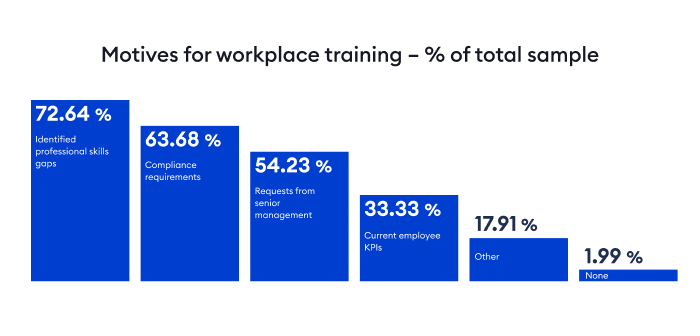
Compliance requirements rank first for quality and analytics specialists (83%), healthcare (79%), goods-producing (75%), and government (71%) sectors. Respondents from the education sector put compliance requirements on par with skill gaps when planning training.
Altogether, these figures show us that workplace training still starts as a formalized regulatory initiative, but is increasingly grounded in practice and pivots toward bridging the actual skills and knowledge discrepancies that industries are facing.
When asked which business areas companies expect to improve with corporate training, respondents most frequently chose customer service and compliance with laws and regulations:
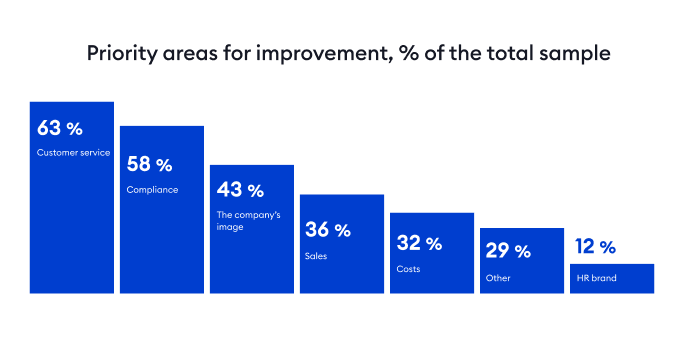
But despite the overall numbers, the responses vary slightly by industry. For example, HR managers (over 75%) name compliance as the core business area they want to improve with training. As a major response, cost reduction is only prominent among QA specialists, who put it on par with compliance and other business areas that are not mentioned in the survey.
Preferred Content Types and Formats of Learning
81% of respondents said they mostly use online courses for training. Nevertheless, 68% of respondents do leverage Zoom training sessions, and 57% continue to use traditional face-to-face learning in the workplace. These results suggest that companies prefer to combine various training activities and mix online and offline approaches in a blended learning format.
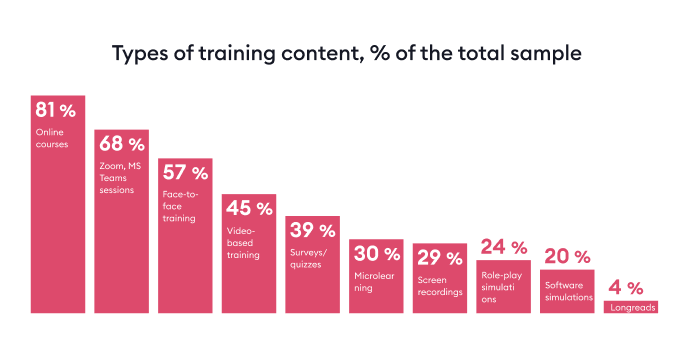
Zoom and MS Teams training sessions are the primary approaches for the banking and education sectors. Face-to-face training in the physical classroom has the lowest share in education (41%) and the highest shares in the goods-producing industry (81%) and government organizations (71%). Interactive role-plays gained recognition in the IT (48%) and goods-producing (28%) sectors.
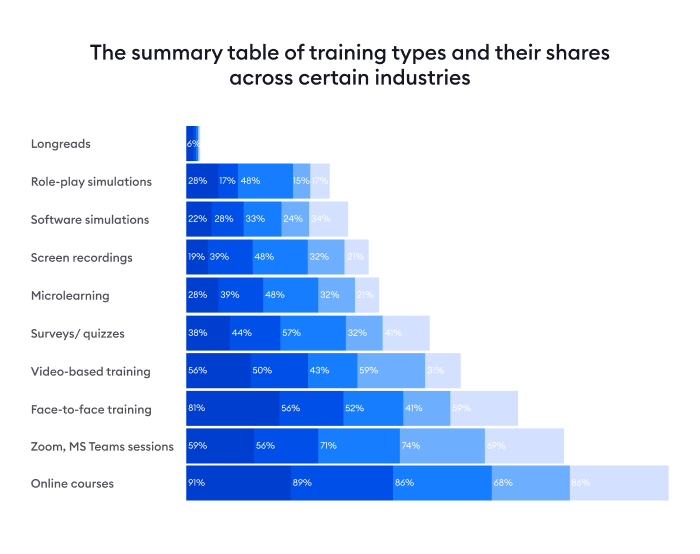
Less than half of the respondents from each sector use assessments, such as surveys and quizzes, in the training process. This may indicate that employers and training managers aren’t paying enough attention to knowledge checks and, as a result, aren’t fully aware of how employees retain new information or their potential learning difficulties.
Engage learners with diverse training content
Interactive quizzes and knowledge checks, mini-games, and role-plays are indispensable for a fulfilling learning experience both in and out of the traditional classroom. If you blend online and offline training, it’s advisable to give learners an opportunity to interact with the content, consolidate knowledge, and test how well they retain it.
With iSpring Suite, you can easily transform your purely informational slide-based courses into eLearning content that’s meaningful and effective. The tool works right in PowerPoint and doesn’t require hours to master. Use your existing slides, enhance them with role-plays, record and edit training videos, add cheat-proof quizzes to reinforce new information, and upload your full-fledged course into any LMS.
iSpring Suite
Fully-stocked eLearning authoring toolkit for PowerPoint. No training required to start!
How Сompanies Identify Resistance to Training
Resistance to training is always reflected in its results. As for the most frequently used training metrics, employers prioritize the training completion rate (66% of all responses). 51% say that they usually look at employee performance as an indicator of training effectiveness. 44% monitor pass or fail rates; these are evidently respondents who use quizzes. Employee satisfaction is used by only 34% of the respondents.
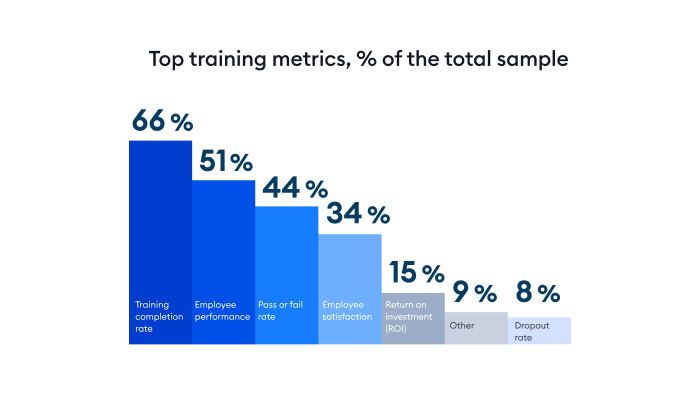
The fact that companies rarely consider employee satisfaction as a training metric should be a matter of concern. This can be an indicator that employers don’t recognize the importance of feedback in training.
Another point is that return on investment (ROI) is not a very popular training metric either, and the majority of respondents don’t see it as a priority. This might signal a need to link training with business results or research the ways that companies establish their training budgets.
When responding to the question of whether or not their employees resist training, employers tend to demonstrate uncertainty — 63% of respondents answered “Sometimes”. Only 21% are confident that their employees don’t resist training in any way. Those who accept that there is indeed resistance account for 16%. A large percentage of uncertainty signifies a poor awareness of training output and a lack of established feedback loops, as well as a general lack of monitoring.
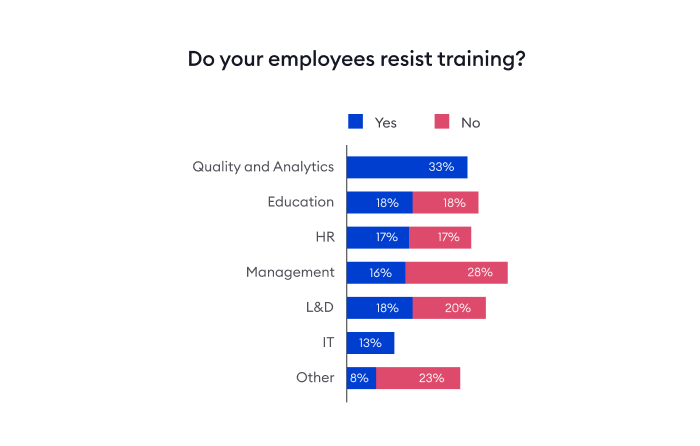
Those who most often say that learners don’t resist training were respondents from the healthcare, education, government, and service-providing industries. On the other hand, respondents in the goods-producing, BFSI, services, and IT/technology industries are those who most often registered that there is a degree of resistance.
What are the signs of training sabotage?
It’s hard to imagine a situation where an employee openly says they won’t take courses or attend live training. Sabotage is often hidden, so it’s important to catch it in time and take action. Our research shows that employee resistance to training manifests primarily as excuses as to why the employee is unable to complete a course or participate in a training session:
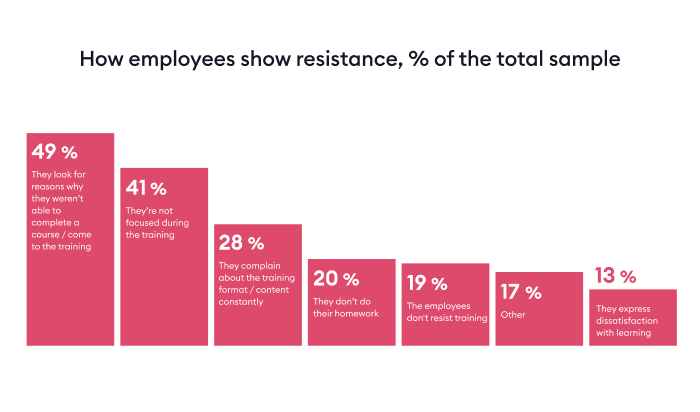
Second on the list are employee complaints about their inability to focus during the training. This can indicate possible issues with training content delivery and its lack of feasibility. Plus, employees are likely to have trouble focusing if training is too rigid and doesn’t fit into their daily schedule. They would, however, embrace the opportunity to choose the time, place, and pace that suit them the most.
How do employees explain their unwillingness to learn?
When asked how employees explain their unwillingness to learn, 81% of employers choose the “They’re too busy to learn” response. Second on the list is the assertion by employees that they already know the material and have all of the needed skills (32%):
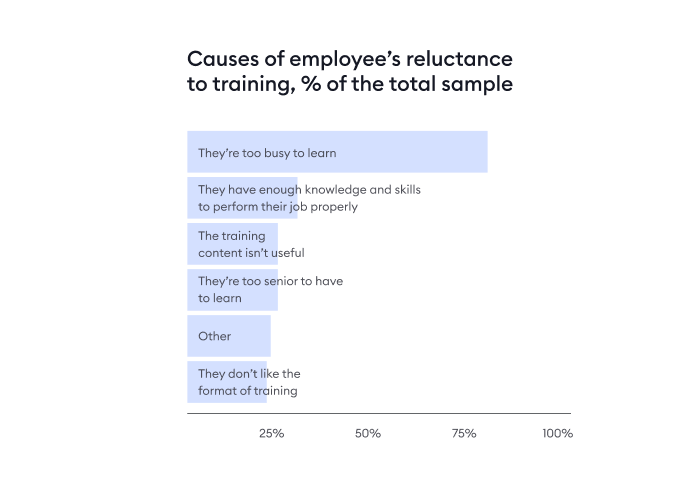
Training can be regarded as lacking value if it doesn’t align with self-perceived competence. If employees claim that they know the material and have all the needed skills, we should question either their competence in the changing labor market or the relevance of the training materials.
Given that employers think of skill gaps as the primary reason for initiating training, it’s an absolute must to assess existing training programs from the perspective of their accuracy and practical value.
Make the training process more flexible and productive
Making training content convenient to consume and easy to access should be a top priority for employers. For this reason, many companies leverage a learning management system to keep everything in one place and let learners take courses when and where it works for them.
With iSpring LMS, for example, it’s easy to check if your employee’s expertise meets the requirements of their position so as to develop personalized training programs that are aligned with their skill gaps. Your team can learn on mobile devices in any spare moment, even when offline, without being stuck at their desks.
To learn more about how iSpring LMS can minimize employee resistance to training and make eLearning more meaningful, you can request a live demo of the LMS. It’s a free session with an iSpring expert who will help you discover iSpring LMS’s capabilities and help you decide if the platform is right for your needs.
Promoting the Idea of Training
64% of training specialists endeavor to convey the importance of training during staff meetings, which includes talking to senior managers about the necessity of training to transmit this idea to the employees. However, 2% of employers threaten their staff with salary cuts and the elimination of bonuses if they refuse to participate in training.
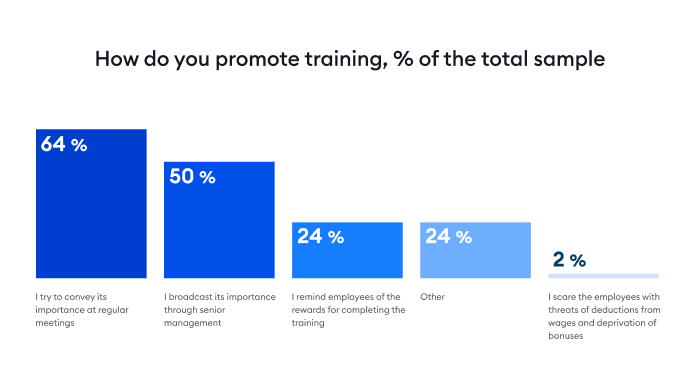
Promoting training during meetings is most popular in IT and service-providing industries, and is least common in presumably more conservative banking and government sectors. For the latter, transmitting this idea through senior management appears to be more relevant.
Among the measures to overcome employee resistance to training, respondents most often explain to employees how it will be beneficial for their job, give them enough time and resources to learn, and collect employee feedback afterwards to adjust training further.
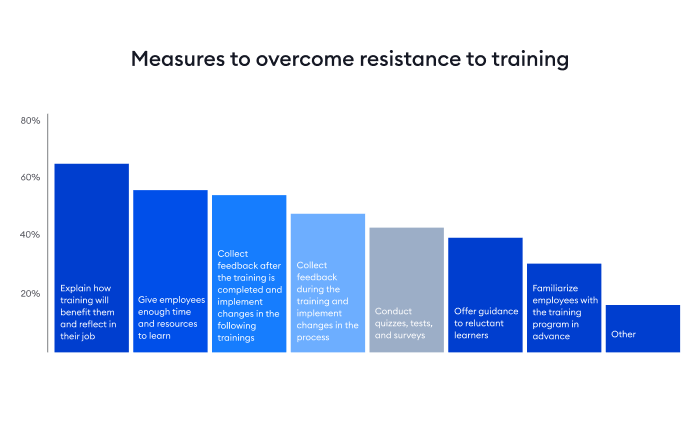
In particular, collecting feedback is most common among HR specialists, while showing the benefits of training is more prominent among L&D and IT specialists, as well as respondents in other roles.
Our research also suggests that certificates remain the principal way to motivate employees to embrace training (40%). This answer is most popular among respondents from the IT, L&D, quality analytics, and management divisions.
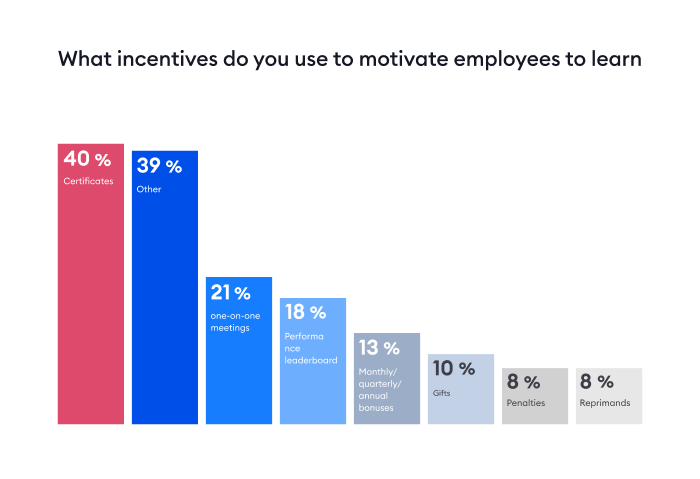
21% of respondents conduct 1:1s to convey the importance of training to a particular employee. Using leaderboards is common for 18% of employers, while 10% motivate their staff toward training with gifts. Finally, a noticeable percentage of employers leverage fear as a motivator: 8% still impose penalties or reprimand their employees if they don’t take training.
Motivate employees intelligently
If you prefer to motivate employees with certificates of completion and/or leaderboards, you can do both with the iSpring LMS. iSpring LMS can issue customizable certificates of completion automatically and compile dynamic leaderboards that put top performers on display. You can also maintain employee engagement by encouraging learners to leave comments and feedback on discussion boards and rate courses with stars.
Check these and other features during a free 30-day trial.
Final Thoughts
Here are some practical insights that will help training managers and employers improve employee engagement and the effectiveness of their training initiatives:
- Keep them accessible and convenient for employees. Synchronous training might not be the most convenient way to train employees with tight schedules. Opt for microlearning and formats that will allow them to fit training into their operations smoothly.
- Gain feedback and survey employee motivation. Don’t plan training programs without adequate consideration and planning. Discuss training needs with employees to make sure your initiatives are aligned with their priorities for professional development.
- Walk the talk and really pay attention to employee satisfaction. It’s best to go beyond pass or fail rates in quiz reporting. Gain employee opinions about whether they’re comfortable with the pace of learning or content formats to prevent resistance to training.
- Ignite the desire to learn at a grassroots level. Boost motivation by showing employees how training can improve the way they work and making it an element of the criteria for advancement.
About the Survey
This research is based on the online survey that was available in the public domain for followers of iSpring Solutions’ social media profiles on LinkedIn and Facebook. Training professionals who represent L&D, management, education, HR, QA, and IT departments were asked to answer 12 multiple response questions about the ways they facilitate, track, and promote employee training in their companies.
The research primarily included respondents from the US and Canada (78%) and a wide range of industries, including the goods producing, healthcare, BFSI, services, service-providing, IT/technology, education, and government sectors.
Here is the distribution of respondents by business size:
- 1–50 employees: 23%
- 51–300 employees: 25%
- 301–1,000 employees: 14%
- 1,000–5,000 employees: 21%
- >5,000 employees: 15%.
Research Team
This study was carried out by iSpring’s expert team, including Natalie Taylor (L&D Consultant), Stacy Clark (Market Research Manager), Anna Law (Market Analyst), and Sofia Green (Content Editor).




